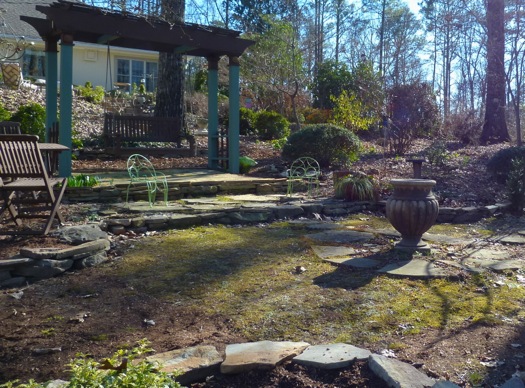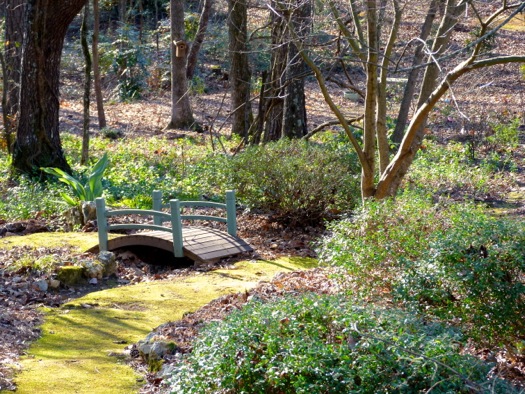My Beautiful May Garden
 Sunday, May 14, 2017 at 3:00PM
Sunday, May 14, 2017 at 3:00PM What makes a beautiful garden? Color, certainly. Healthy plants. Proportion and balance. Variety. Movement and flow, repetition. Fragrance. All those things, but much more. A beautiful garden can be humble or grand. It is highly personal. For me: a peaceful atmosphere, comfort, birdsong, memories, a little whimsy.
Color, certainly. Healthy plants. Proportion and balance. Variety. Movement and flow, repetition. Fragrance. All those things, but much more. A beautiful garden can be humble or grand. It is highly personal. For me: a peaceful atmosphere, comfort, birdsong, memories, a little whimsy.
May is a beautiful month! I want to be outside every day, tending my garden. I love Confederate jasmine (Trachelospermum jasminoides), which is in full bloom on the arch by the patio. The intoxicating fragrance is a delight whenever I walk under it. I can also catch a whiff of rosemary. Nearby, pink 'Anthony Waterer' Spirea is blooming.

Coral drift roses line one edge of the patio, along with bacopa and a silvery artemesia:
On the patio table is a ceramic green rabbit, a souvenir I brought home from Hills and Dales Estate in LaGrange, Georgia, a very grand and gorgeous garden!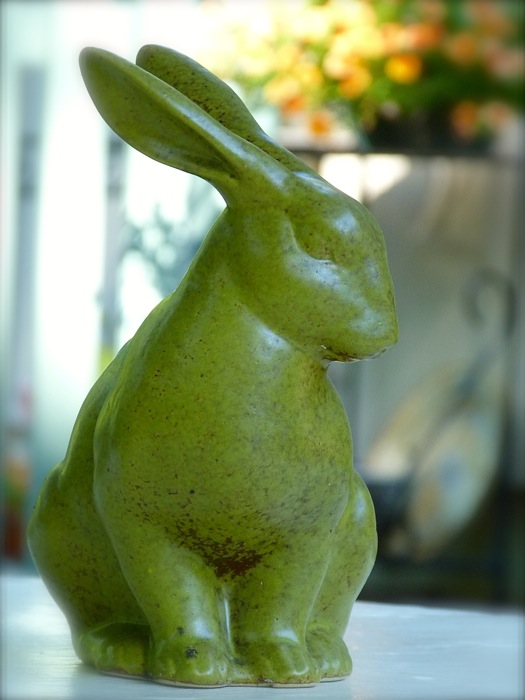
Here are more images of some of the flowers in my May garden: 1st row: 'Penelope' rose; 'Anthony Waterer' spirea; Lichnis coronaria, commonly called rose campion. 2nd row: Yarrow; Calibrachoa; 'Snowflake' Hydrangea. 3rd row: Rosa palustris, also called swamp rose; Coral honeysuckle; Gardenia Jasminoides 'Kleims Hardy', a dwarf gardenia bush.
1st row: 'Penelope' rose; 'Anthony Waterer' spirea; Lichnis coronaria, commonly called rose campion. 2nd row: Yarrow; Calibrachoa; 'Snowflake' Hydrangea. 3rd row: Rosa palustris, also called swamp rose; Coral honeysuckle; Gardenia Jasminoides 'Kleims Hardy', a dwarf gardenia bush.
As much as I love flowers, I am also drawn toward colorful foliage. I purchased a variegated geranium without even knowing what color the blooms were; the leaves are spectacular! It has started blooming now, and the orange blooms complement its foliage perfectly. Near the steps leading from the patio to the arbor garden are two 'Francis Williams' Hostas, Japanese painted fern, and an interesting plant with variegated arrow-shaped leaves, 'Red Dragon' Persicaria. I have placed an unlikely companion next to one of the the hostas: a red poinsettia, left over from Christmas and still looking good!
 Clockwise from top left: 'Francis Williams' Hosta with poinsettia in background and a neighboring branch belonging to Edgeworthia chrysantha; A variegated geranium; 'Red Dragon' Persicaria and 'Francis Williams' hosta; 'Red Dragon' Persicaria and Japanese painted fern.
Clockwise from top left: 'Francis Williams' Hosta with poinsettia in background and a neighboring branch belonging to Edgeworthia chrysantha; A variegated geranium; 'Red Dragon' Persicaria and 'Francis Williams' hosta; 'Red Dragon' Persicaria and Japanese painted fern.
I have featured 'Tropicana' Canna lily a number of times over the years. Its bold colors hold up well to the hot sun that bathes the front of our house in summer: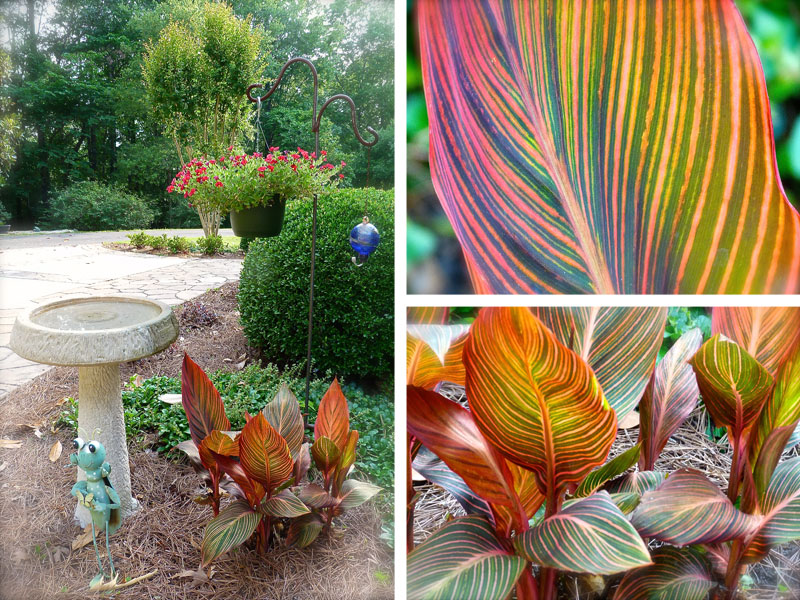
The stone steps leading down to the much shadier woodland garden are located across from the front parking area. One of my favorite views of the woodland garden (shown many times on this blog!) is seen from the bottom of the steps. Moss paths tie different parts of the woodland garden together and give it a peaceful, quiet atmosphere:
The white birdhouse in this photo was home to a family of bluebirds, recently fledged: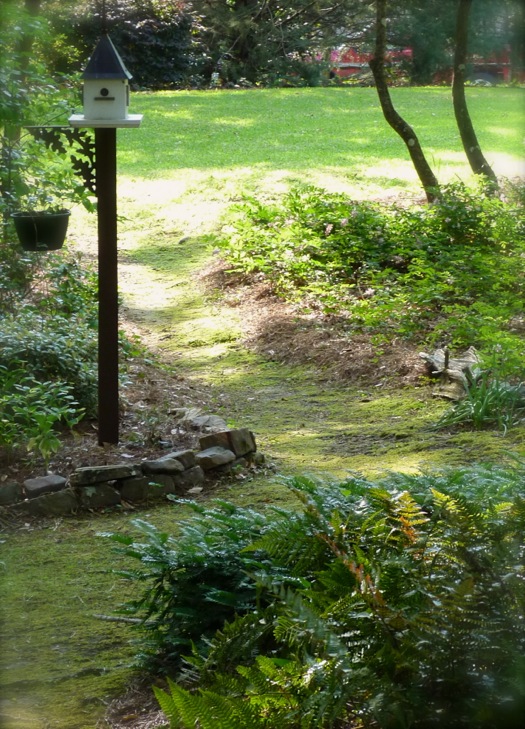
I put this little woodland sitting area in last year. It is near an area featuring ferns and native azaleas. Moss and ground covers will soon carpet the ground around the chairs. That is an old iron magazine rack holding small potted begonias. The blue flowers are Tourenia fournier, also called wishbone flower. It is my newly discovered favorite annual for shade. Tourenia comes in various colors. The cobalt blue blooms of this one are fabulous. I also planted lime green Scotch Moss (Sagina subulata), Creeping Jenny, and wild violets in this area. :
More plants in the woodland garden: 1st row: Japanese felt fern; 'Whitewater' weeping redbud; Hardy begonia. 2nd row: Athyrium filix-femina 'Lady in Red'; bench next to fern glade; Polystichum acrostichoides, a native fern also known as Christmas fern. 3rd row: Hellebore whose red blooms have faded to green; wild violets; Woodland rabbit with Colocasia.
1st row: Japanese felt fern; 'Whitewater' weeping redbud; Hardy begonia. 2nd row: Athyrium filix-femina 'Lady in Red'; bench next to fern glade; Polystichum acrostichoides, a native fern also known as Christmas fern. 3rd row: Hellebore whose red blooms have faded to green; wild violets; Woodland rabbit with Colocasia.
This beautiful Bird's Nest fern (Asplenium nidus) stays in the woodland garden until cold weather arrives. It spends the winter inside, but it flourishes outside when the weather warms:
What about you? What makes you pause in a garden? How do you define beauty? The wonder is that I have seen many beautiful gardens, and they are all different!
You may also enjoy my previous post, Seven Elements of a Beautiful Garden.
